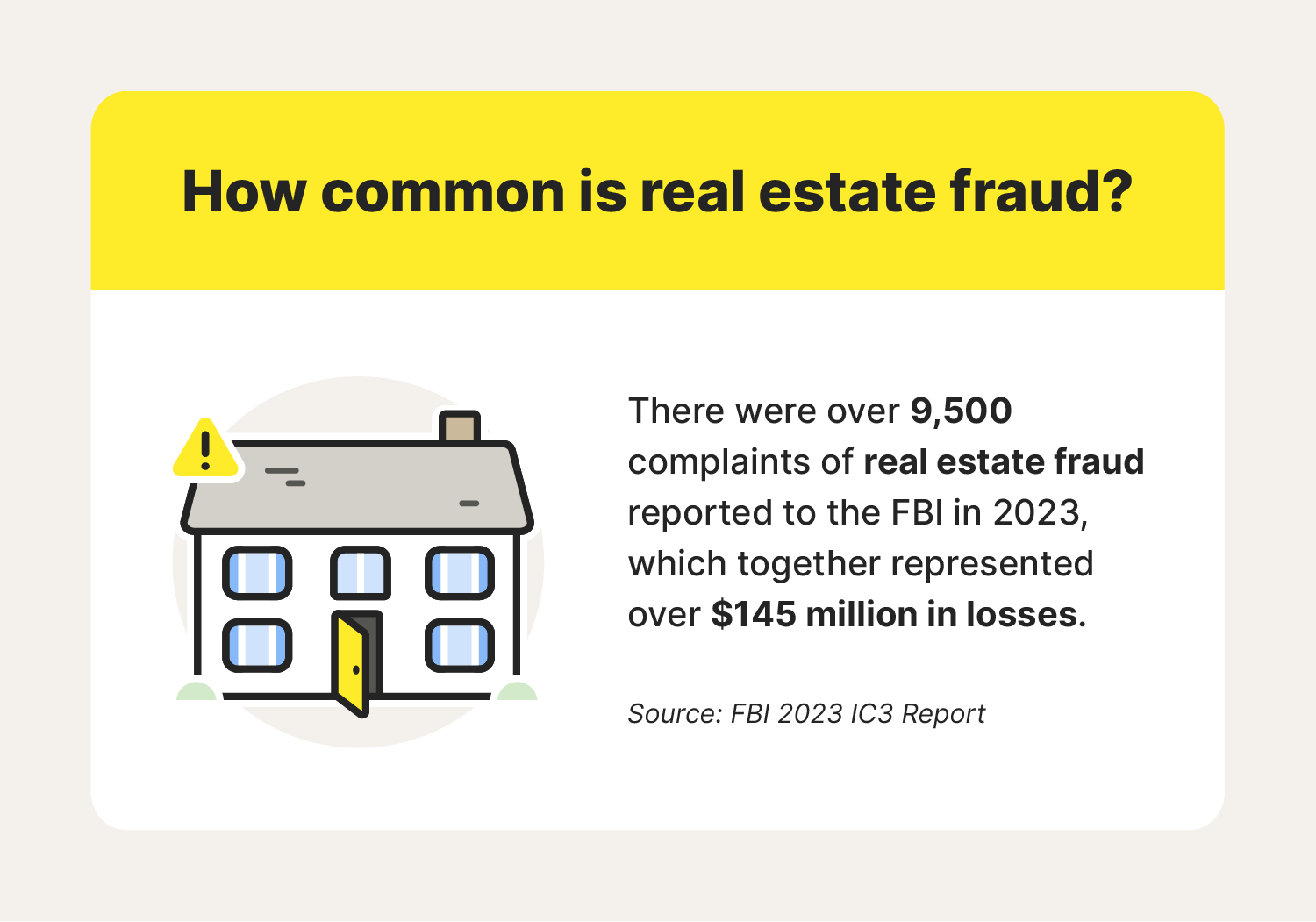What is home title theft?
Home title theft, also known as deed theft or deed fraud, is when someone illegally transfers a property title without the homeowner’s consent, effectively stealing the home ownership rights. It often starts with the criminal committing identity theft, gathering information that allows them to impersonate the actual owner to bypass identity checks.
To attempt a home title transfer, criminals typically need a copy of the current deed, mortgage details, and an identifying document like a passport or driver’s license. They may try to steal these documents directly from you, or trick you into sharing them using phishing schemes or other scams. Alternatively, they might just aim to gather enough information to create convincing forgeries.
If they’re able to successfully impersonate you and transfer your home title into their name, they can do one of several things to make quick money:
- Refinancing fraud: The thief can try to withdraw equity from your home by refinancing with a new mortgage, potentially leaving you with additional debt that you didn’t take out.
- HELOAN or HELOC fraud: A home equity loan (HELOAN) or home equity line of credit (HELOC) could allow the thief to commit property-related loan fraud, using your property as collateral for instant cash.
- Property sale fraud: With your home title in their name, the thief can list your home for sale without your knowledge, ultimately scamming someone else into buying a property that isn’t actually available.
Despite being a relatively uncommon form of fraud, victims of real estate scams and crimes like home title theft lost over $145 million in 2023, according to the FBI’s Internet Crime Report. Building your awareness of the risks and knowing how home title theft works can help you avoid becoming part of that statistic.


How can your home title be stolen?
Before fraudsters can steal your home title, they need to steal your identity. They aim to do this by getting access to sensitive personal information, like your identification documents, Social Security number (SSN), or mortgage details. This personal data then helps them pretend to have the authority to transfer your home title or refinance your property.
These are some of the main ways criminals might try to steal your personal information and, by extension, your identity:
- Phishing: Phishing is a social engineering tactic where fraudsters impersonate trustworthy people or organizations, often in emails or texts. Phishing messages might claim you need to provide sensitive information to “protect your bank account” or prompt you to visit a fake webpage designed to trick you into revealing personal data.
- Phone scams: Fraudsters may call you posing as a customer support representative from your bank or offering you a prize for a competition you didn’t enter. However, they’ll claim that they need some personal information, like your SSN or credit card details, before they can help you or release the prize.
- Mail theft: Your mailbox likely contains a trove of sensitive information, including mail from your bank, credit card provider, and government offices. This offers mail thieves access to valuable fragments of your identity that can be pieced together to facilitate full identity theft.
- Dumpster diving: If you’re not careful to shred or otherwise carefully dispose of documents containing sensitive information, like your bank account details or SSN, they could be vulnerable to dumpster-diving fraudsters.
- Hacking public Wi-Fi: Public Wi-Fi networks, like those in airports or cafes, may be unencrypted and unsecured. This can leave any data you transmit on the network vulnerable to hackers, who aim to intercept or redirect your internet traffic to access valuable personal information.
What are the signs of home title theft?
Suspicious updates to your title deed, unexpected or unexplained changes to your accounts or credit report, and unsolicited contact from people or businesses you don’t know are some of the most common signs of home title theft.
Here’s a more detailed look at the signs you may be getting targeted by a home title thief:
- Updates to your deed online: Many counties offer online portals that allow you to see a scanned copy of your home’s latest title deed. Perform a Google search for “check title deeds” followed by the names of your county and state. When your county’s website appears (probably as a “.gov” site), click through and search the official website for your address. If you notice your property’s deed has someone else’s name on it, you might be a victim of home title theft.
- Regular mail not arriving: If mail you typically receive regularly, like utility bills or local authority notices, stops arriving at your home, it may indicate that an identity thief has taken control of your home title and is redirecting mail to an address they own.
- Changes to your credit report: A fraudster refinancing your property or getting a home equity line of credit or loan in your name will result in unfamiliar items appearing on your credit report, like new mortgages or lenders you’ve never contacted.
- Phone calls from lenders or estate agents: Unsolicited calls from mortgage lenders or estate agents showing interest in your property could signal that an identity thief has contacted them after stealing your home title.
What to do if your home title is stolen
If you realize your home title has been stolen or your property has been refinanced without your authorization, contact the relevant authorities and take steps to protect your identity from being used in further fraud as soon as possible.
These are some of the most important steps to take following home title theft:
- Report the fraud to your bank: If you have a mortgage that may be implicated in home title fraud, contact your lender’s fraud department immediately and explain the situation. They might have a process for dealing with title theft and could help you reverse any unlawful changes.
- Contact the credit bureaus: An identity thief who stole your home title may have access to information that lets them get credit in your name. Contact the three major credit bureaus (Equifax, Experian, and TransUnion) and set up a fraud alert or credit freeze to safeguard against further fraud, like scammers opening new accounts that could damage your credit score.
- File a report with the FTC: File an identity theft report with the Federal Trade Commission (FTC) at IdentityTheft.gov, including details about the fraud and any relevant supporting documents. They’ll provide you with a personal recovery plan, guide you through key steps, and may use your report to tackle future cases.
- File a police report: Home title theft is a crime, so you should contact your local police department to submit a report. Even if they can’t catch the criminal, your report will serve as an official note that your identity was stolen, potentially acting as proof if you need to dispute fraudulent charges or derogatory marks on your credit report in the future.
- Shore up your digital security: If any of your online accounts, including online banking or credit card accounts, were implicated in the fraud, refresh your security by choosing new strong passwords to help protect against further unauthorized access.
9 tips to help prevent home title theft
Knowing what to do when you’re targeted by home title theft is critical, but taking steps to help protect against it in the first place can keep your property safer from fraud. Safeguarding your personal information, looking out for the initial warning signs of identity theft, and monitoring for changes to your home title are some of the best ways to do that.
Here’s a more detailed look at what you can do to help prevent home title theft:
- Protect your personal information: Fraudsters hoping to steal your home title first need to steal your identity. Stay wary of phishing schemes and other scams — only ever provide sensitive personal information to trusted authorities, and when absolutely necessary.
- Keep track of mail and bills: Knowing what mail or bills you should receive, and when, will help you quickly identify when they go missing, potentially indicating you’ve been targeted by a mail thief.
- Shred sensitive mail and documents: Dumpster-diving fraudsters aren’t averse to rummaging through your trash to find sensitive information in discarded letters or bills. Shred any documents containing personal information before you throw them away to help safeguard your identity.
- Use county consumer notification services: Some counties offer free notification services that alert you by email or text whenever a new document is recorded for your property, helping you catch potential home title theft. Google search “consumer notification service” followed by your county and state names to see if this is offered in your county.
- Monitor your credit: Home title thieves may aim to refinance your property or use the equity you’ve built as collateral for a HELOAN or HELOC, but signs of this type of fraud will appear on your credit report. Help monitor your credit with LifeLock Ultimate Plus to get alerts of key changes to your credit report that may indicate home title theft, and consider placing a credit freeze or fraud alert to limit fraudulent access to your credit file.
- Use a VPN: Using a VPN while connected to potentially unsecured public Wi-Fi networks can help protect the data you transmit from being read by hackers and used in identity theft.
- Follow internet safety best practices: Following simple cybersecurity advice, like avoiding clicking suspicious links and using strong passwords, can help protect you against online threats that could compromise your personal information.
- Stay on top of new scams and scam tactics: Scammers are constantly coming up with new tricks and schemes to steal personal information or commit identity theft. Stay up to date with the latest tactics to increase your chances of being able to spot a scam so you can protect yourself.
- Get home title monitoring: Also known as a home title lock, home title monitoring services like LifeLock Home Title Protect offer alerts for changes in property ownership, new lenders, and default notices. This makes it easier to detect home title theft as it happens, meaning you can take a proactive approach to help protect yourself.
Help protect your home title
Your home is probably the most valuable asset you own, so protecting it should be a priority. Join LifeLock Ultimate Plus for home title monitoring that can alert you to home title theft attempts, along with a range of identity theft protection features that can help you safeguard your personal information and provide early warning of potential identity theft. You’ll also benefit from the support of a U.S.-based personal restoration specialist if your identity is ever stolen, providing a valuable lifeline in a worst-case situation.
FAQs
Is home title theft real?
Yes, home title theft is real. It’s a form of real estate fraud that typically involves identity theft and forgery. While it may be extremely difficult for fraudsters to pull off given the protections involved in the home title transfer process, it is possible in certain circumstances.
How common is home title theft?
Home title theft is not particularly common. It’s just one type of real estate fraud, which is one of the least common types of fraud according to the FBI’s Internet Crime Report. However, it’s still sensible to take precautions to help protect against the risk, as the potential consequences of falling victim to home title theft can cause significant damage.
What happens if my home title is stolen?
If your home title is stolen, it could leave you vulnerable to other types of real estate or financial fraud. The criminal may be able to refinance your home, use it as collateral to extract equity, or even list it for sale without your knowledge.
Who do I call to report home title scams?
If you find out that you’ve fallen victim to home title theft, or have had your identity stolen and fear it’s part of a real estate fraud scheme, contact your mortgage lender, the credit bureaus, and the FTC as soon as possible.
What’s the difference between title insurance and title lock insurance?
Home title insurance is an insurance policy you can take out when you first purchase a home, protecting you against legal challenges or claims to your property ownership. Title lock insurance, sometimes known as a “title lock” or “home title monitoring,” isn’t an insurance policy. It’s a title protection monitoring service that can alert you if someone attempts to make changes to your home title, like fraudulently transferring it into their name.
Editor’s note: Our articles provide educational information. LifeLock offerings may not cover or protect against every type of crime, fraud, or threat we write about.
Start your protection,
enroll in minutes.
LifeLock is part of Gen – a global company with a family of trusted brands.
Copyright © 2025 Gen Digital Inc. All rights reserved. Gen trademarks or registered trademarks are property of Gen Digital Inc. or its affiliates. Firefox is a trademark of Mozilla Foundation. Android, Google Chrome, Google Play and the Google Play logo are trademarks of Google, LLC. Mac, iPhone, iPad, Apple and the Apple logo are trademarks of Apple Inc., registered in the U.S. and other countries. App Store is a service mark of Apple Inc. Alexa and all related logos are trademarks of Amazon.com, Inc. or its affiliates. Microsoft and the Window logo are trademarks of Microsoft Corporation in the U.S. and other countries. The Android robot is reproduced or modified from work created and shared by Google and used according to terms described in the Creative Commons 3.0 Attribution License. Other names may be trademarks of their respective owners.







